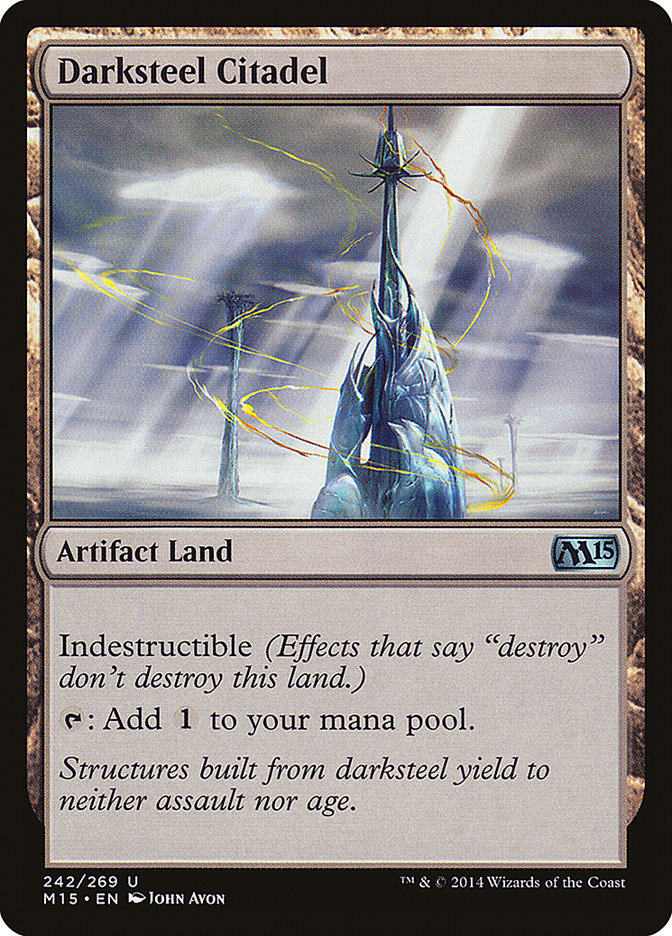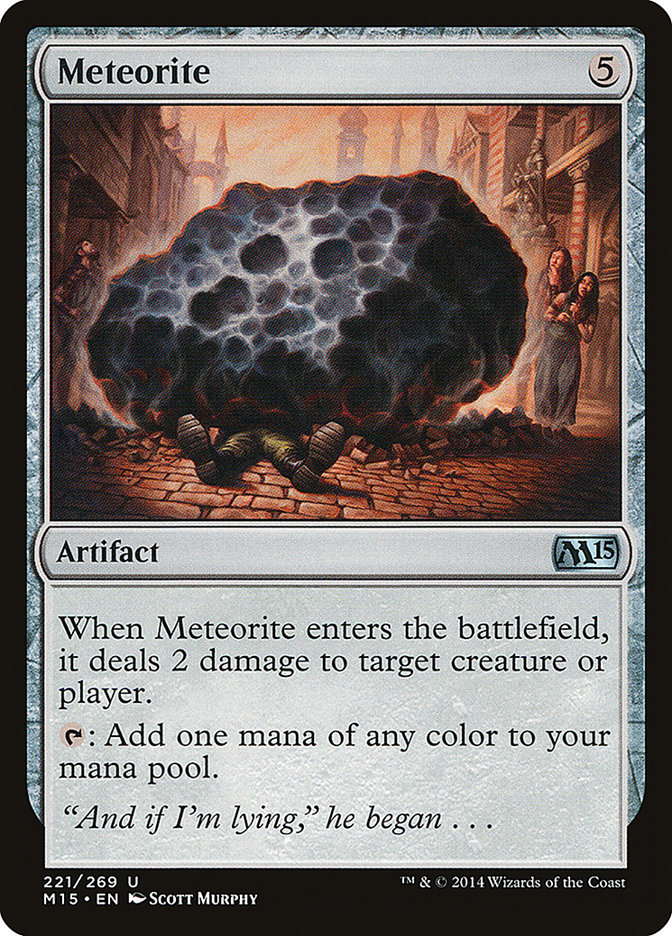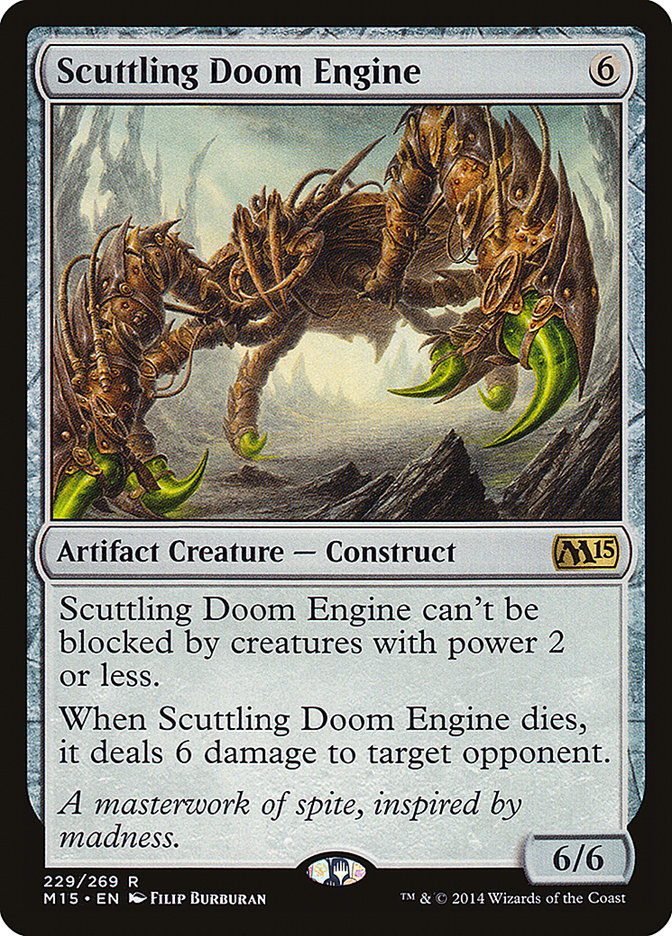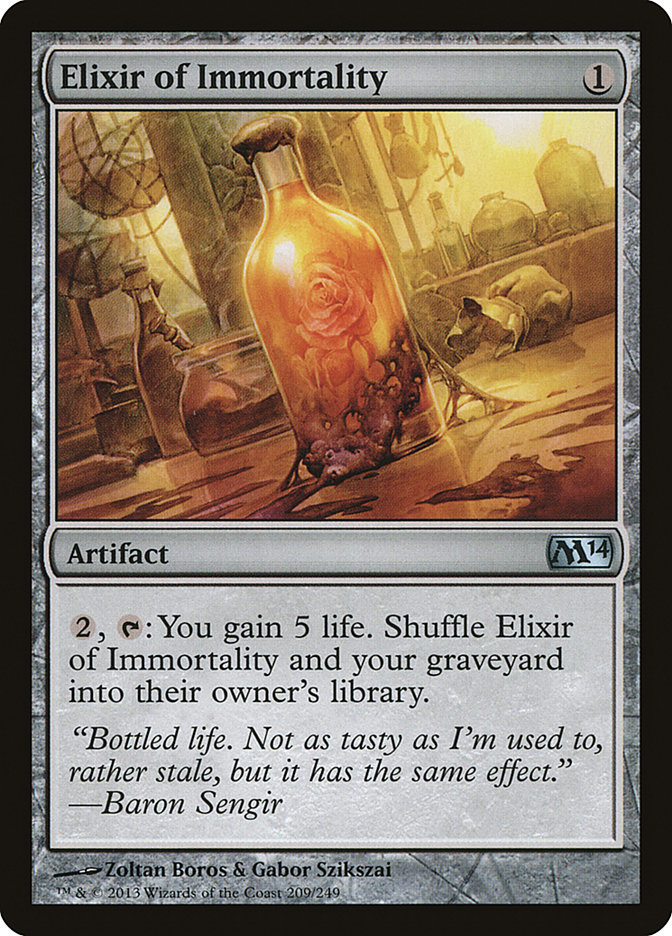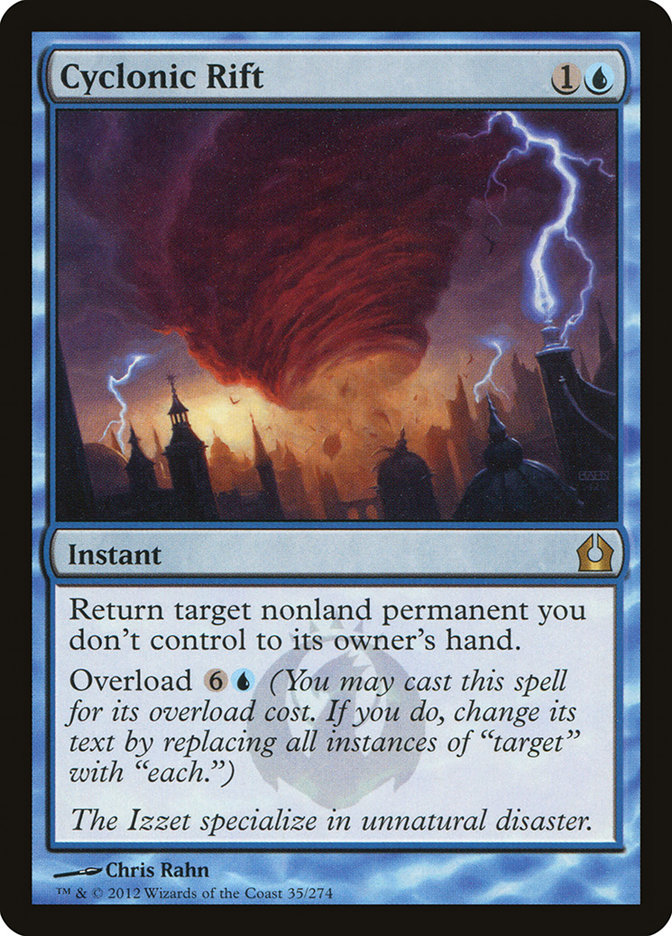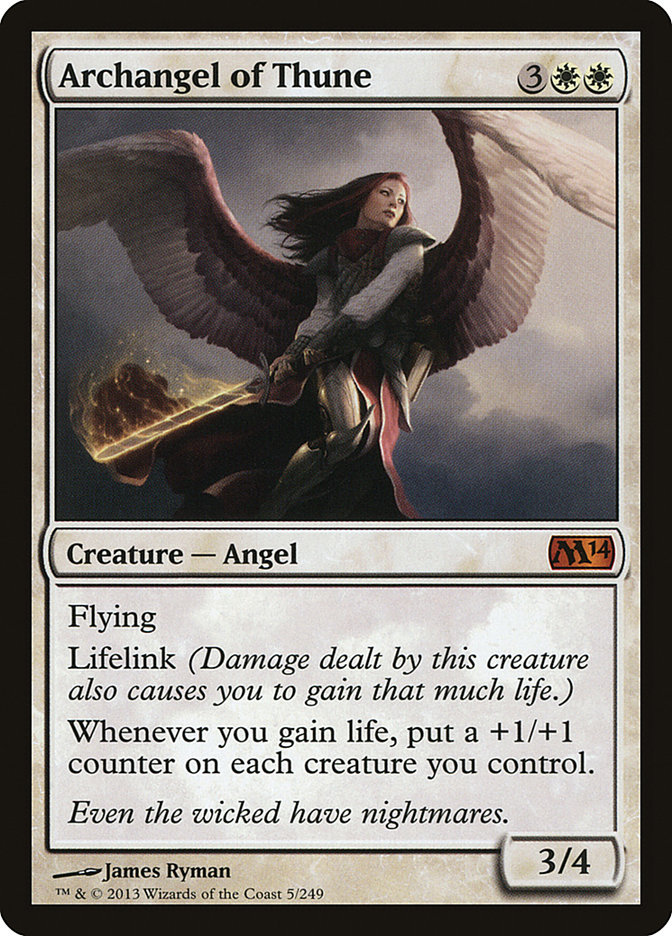
A few days ago, I saw this on my Twitter notifications:
@AdrianLSullivan I must know… What was the logic behind the Trading Post in the board at GP Chicago?
— Brandon E (@mtg_watercliff) July 8, 2014
In my head, I couldn’t help but hear it as a variant of Inigo Montoya’s conversation with the Man in Black:
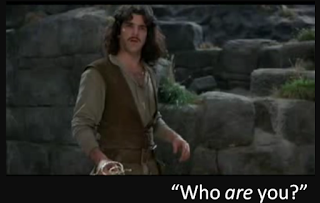
“Why Trading Post?”
“Reasons.”
“I must know…”
“Get used to disappointment.”
I wasn’t actually going to answer this on Twitter, largely because it seemed impossible to do in 140 characters (especially 140 minus a username). And so, it seemed to be one of those moments where I was going to largely be saying to Brandon, “Get used to disappointment.”
All of this, of course, was happening right in the moment of “spoiler season”, where so many of us are glued to the various spoilers, trying to glean what we can about M15 before the set becomes legal or before the prerelease. People have many different ways of going over spoilers, but here is my method: as the spoiled cards come more frequently, check the spoilers more often, and any time that there is a new card, look over the entire spoiler in full once again. In part, this is because sometimes previously spoiled cards get updated or fixed, but mostly this is just to ensure that I have all of the cards completely in my mind by the time that I sit down at the Prerelease, as well as have them in my mind as I’m thinking about new decks.
(Incidentally, I’ll be at Misty Mountain Games for the Prerelease, so if you’re in Madison, Wisconsin, I’ll see you there! I don’t expect to show up for the so-called “Midnight Prerelease”, at least not to play; I may just pop in late in the evening to see how people are doing. I’m not sure about you, but the days of hitting a midnight event, then showing up in the morning for more are in the past for me, I think.)
And so it was, going through the M15 spoilers, I noticed three cards that really caught my interest:
Visions of Trading Post flitted through my head, and I thought back to Brandon’s question:
“I must know… What was the logic behind the Trading Post in the board at GP Chicago?”
Brandon wasn’t the only one who had this question. So, especially given the ideas rumbling through my head with M15, I’m going to answer the question.
The Logic for U/W Control
There are two camps when it comes to Sphinx’s Revelation control decks: the Elixir of Immortality camp and the No Elixir of Immortality camp.
Frankly, not only do I think the No Elixir camp is wrong, I don’t think their arguments make any sense. I hear “Elixir of Immortality just isn’t necessary in the current metagame”. I agree that you can win with Sphinx’s Revelation decks without it. However, there is no deck that I would sideboard Elixir of Immortality out against, and I think that it makes every matchup you have better. It’s not that it is necessary, it is that you are underselling yourself when you don’t play it.
This is a pretty bold claim, so let’s talk about it before we go any further.
First, when you have Elixir of Immortality in your deck, it allows you to play your game very differently. If you are in an early game against any opponent and you have a finisher of some sort that you can’t afford to cast (or don’t dare cast), should you miss a few land drops, you can afford to discard the finisher. If you want, you can just drop an Aetherling unprotected. If your opponent kills your method to end the game, ultimately it doesn’t matter. Similarly, you don’t have to count your counterspells left in your deck and ration them out slowly for those situations where you really, really need them.
Elixir in your deck means that you have an engine. This is why it is actually quite important to have Divination in addition to Jace, Architect of Thought in your Elixir builds, so that you can accomplish a late-game where you will never run out of any resource that isn’t removed from the game. If, for some reason, the engine is disrupted by the destruction of the Elixir of Immortality or by it being hit by discard or a counterspell, you are still the same deck as any other non-Elixir build. One of the reasons that I think Andrew Cuneo’s build of U/W Control–piloted by Reid Duke and William Jensen at the SCG Invitational in Columbus–was actually misbuilt is that it can’t revert to being a non-Elixir deck. It simply isn’t capable of it. On the other hand, with both an Aetherling and an Elspeth still in my deck, I’m on par with many other U/W Control decks that have had one of their “finishers” removed; many have one additional finisher, but quite a few only have three and losing one puts us on the same footing.
In Standard, there are no other decks that have the inevitability of Elixir of Immortality/Sphinx’s Revelation decks. In any of the truly grinding matchups, after you get over a certain hump, it doesn’t matter what kind of card advantage the opponent might have going. Neither multiple Underworld Connections nor Courser of Kruphix/Domri Rade can keep up with a late-game Sphinx-fueled Elixir deck. So, at this point, every deck with Domri Rade, Underworld Connections, or Sphinx’s Revelation are decks you definitely want to have Elixir against.
Yes, Elixir can be a semi-dead card to have in your opening hand, or even a liability. A bit more than 10% of opening hands will contain an Elixir, but fortunately this is only a real problem against Thoughtseize decks, as every other matchup won’t punish you for having this card in your hand. Yes, the card may be, in the early game, purely an investment in card disadvantage, but this isn’t usually a problem.
One of the things that you find in all of the Sphinx’s Revelation decks is that moment where you discard. If you’ve played these decks, you know what this is like. Whether it is from the casting of Sphinx’s Revelation, from the activating of Jace, Architect of Thought, or the use of Divination, you end up discarding in a great many of the games that you win.
This implies that you are actually getting more card advantage than you can actually make use of, even if you need every bit of that card advantage to take the game in hand. With this in mind, I’ve made use of several cards that are, generally speaking, cards that come with a built-in loss of card advantage but can be useful in keeping a game going. In all of my builds, I’ve been running:
In the Detention Sphere builds, I’ve also been running:
Except for some uncommon circumstances, the bounce spells are card disadvantage that are being used as a versatile means to stay alive. Cyclonic Rift at two mana and Disperse are both basically answers to anything that doesn’t have hexproof, albeit with the understanding that you’ll be down a card for your temporary answer.
The return on this is time to get deeper into the game. Elixir of Immortality can function much the same way. Even if Elixir of Immortality is a “bad Fog” in the early game against those decks that are planning on attacking you, the fact of the matter is that Elixir of Immortality ends up being a card much like Cyclonic Rift: in the early game, it helps you stay alive (at the cost of a card), and in the late game, it helps to devastatingly lock games out.
While Elixir is obviously good against any pure Burn deck, undoing a solid amount of the work the Burn deck was trying to accomplish, against those decks that are actually dealing sustained damage, just getting the buffer from a “Fog” is a part of what can give you that buffer in your life total that will let you survive to the point where your late game takes over.
In the end, Elixir of Immortality is just giving you what you want in literally every matchup. Yes, you don’t need it to win in any of them, but having played both builds, my experience is that it increases your chance to win in every matchup I’ve played. The small potential cost in 10% of your early games is offset by being able to fundamentally change the way you approach your resources throughout all of your games. If you want to understand this, I go into the idea of the returns of Elixir in my article, “How To Learn to Love the Fun-Of One-Of”.
All of that being said, here is my Elixir of Immortality/Sphinx’s Revelation deck from Grand Prix Chicago:
Creatures (1)
Planeswalkers (5)
Lands (26)
Spells (28)

Lest we mistake this article as an Elixir of Immortality article, let me remind you that this article is about this card:
You can read the abilities on the card, but let me put this in other terms:
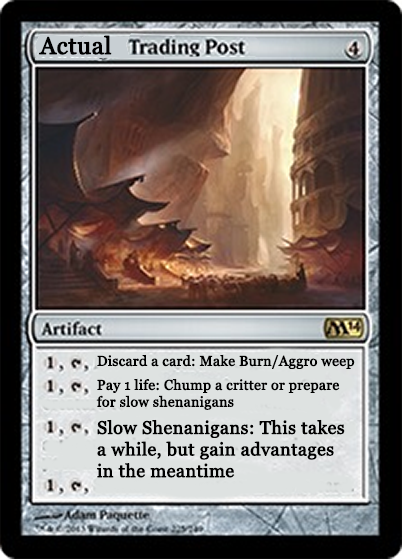
The most common use of Trading Post is the Burn matchup.
If you didn’t know it, I actually love Burn as a deck. I think it is an incredibly powerful deck in today’s Standard, and I think it is very possible it will just get better after M15. Going into GP Chicago, I had a great deal of respect for Burn, and even though I hadn’t lost to it in a sanctioned match with my U/W Control deck, I had had a ton of matches be incredibly close.
Even before Grand Prix Moscow, I knew that I wanted to respect the deck a bit more, and after Grand Prix Moscow, I knew that my decision to start playing Trading Post was an important choice. “1, T, Discard a card: Make Burn weep” was just too good a card not to play.
I played Burn five times at Grand Prix Chicago. Again, the matches were generally very, very close. However, Trading Post was a huge weapon to lock out their chance to win the game. To see this in action, check out this game:
http://www.twitch.tv/magic/b/540841576?t=50m48s
I love the commentary from Marshall Sutcliffe and Brian David-Marshall in the moments after I drop it into play:
Marshall: “Oh, no way! Trading Post!?”
Brian: “Wow!”
Marshall: “That could change things!”
Brian: “Woah. G. D.!”
A few moments later, I activate it.
Marshall: “It happens? No Skullcrack, no nothin’? Okay, this game is over!”
And it was.
The threat of four life every turn is really just too much for a Burn deck to overcome. Though, I suppose you might say that this card has some pretty steep competition:
Now, don’t get me wrong – I love this card too. It can be an incredible weapon against creature decks, and is, in my opinion, particularly great against Blue Devotion, for example. However, Archangel of Thune is just not as good as Trading Post against Burn.
A part of the problem is timing. Archangel not only delays the start of life gain by a full turn, but it also gains life at a slower rate. In addition, the Archangel might not ever be able to give a single point of life because it might just be dead. Most importantly, you can only gain life at a particular time with Archangel: during combat.
In the Burn matchup versus any Sphinx’s Revelation deck, you get to a point that I think of as “the Cold War moment”, where, properly played, both players just start looking at each other, waiting for the other to act. In this situation, a Trading Post basically just blows open the waiting game, as every activation demands a Skullcrack.
There will be times that you will simply not activate it for fear of their Skullcrack, but then this means that you can actually afford to cast your Revelation for cards, leaving mana open for whatever countermagic you like and one mana for the Trading Post activation that you can leave in reserve to respond to Skullcrack. In other situations, you can open with Trading Post for four life, and if they respond, you can make the move to cast the Revelations in response.
Once you’re at a stable life total, you can just start buffering it up so that the game is completely out of reach for basically any play that they might have. Their only option to win such a game is for them to build up an army of creatures, but this can be a difficult proposition.
While Trading Post doesn’t come in against all of the decks that try to attack your life total, it still does come in against any of the most aggressive decks, especially any that run Boros Charm or other burn spells. Here, this card is often not as good as Archangel of Thune, but it still is useful. In addition, being able to drop a card that can recover your life total into play and follow up with a Supreme Verdict can be huge. If you aren’t afraid of something going wrong, turning Trading Post into a Forcefield for just a moment is an alternative means of life preserving that the card can afford against creature decks, as well.
Still, a lot of people can understand the use of Trading Post against Burn very easily. Even against a lot of the most aggressive decks, it makes sense. But why bring it in against other control decks?
What is to be made of moments like this, for example?
http://www.twitch.tv/magic/b/540904496?t=1h51m30s
The first and most important reason to have the Trading Post in the Sphinx’s Revelations mirror is this:
Most of the best control players realize that the fight over Elixir of Immortality is actually one of the most important fights that can occur in the Sphinx’s Revelation mirror. If a player is aware of this, Thoughtseize, a counterspell war that ends poorly, or even a Jace, Memory Adept can mean that your Elixir of Immortality will end up in the graveyard. Trading Post can be an insurance policy against this.
Further, it actually doubles up your Elixirs beyond being an insurance policy. You can start treating the initial Elixir the way you treat your Aetherling and Elspeth: while you don’t want to just toss them away, you can afford to do so, and you can afford to use them to start a counterspell war that you don’t intend to win. Being able to afford to lose counterspell wars more than your opponent is a huge deal.
The second reason for Trading Post is, surprisingly, the life gain clause on the card.
Remember how I said earlier that these control decks end up having too much card advantage? Now, whenever this happens if you can see that it is either going to happen, or it is about to happen, for the low cost of one mana you can gain life.
The cards are generally already going away. Granting yourself this life buffer can mean that you have one or two additional turns in the portion of the game where your opponent is trying to kill you, typically with an Aetherling or an Elspeth ultimate. This time can be enough to find an answer.
Against Aetherling, even in lieu of an answer, the first life activation of Trading Post will often grab you one turn, but take a typical Trading Post late game where perhaps you and your opponent are both at about 29 life when they cast their Aetherling. You lose the fight and on your turn, manage to get a Trading Post in play (or already have one).
Previously, this could be a four turn clock, should they have the desire and means to go for the kill immediately. With a Trading Post in play, however, that four turn clock can turn into a six or seven turn clock, and that is without a “Fog” to increase the potential for another free turn. Each activation of Trading Post only costs you one mana, but it eats up half of the effect of an all-in Aetherling, which is usually costing them five or six mana.
This difference can mean you win the Aetherling race if you both get Aetherlings down. Or it can just mean that you have time to find an answer. Or it can mean you get “the lock”, where you leave them with their Aetherling, but you have successfully gotten to Sphinx’s/Elixir recursion, and it doesn’t matter what they do any more.
The ability of Trading Post to enact either of the above strategies is why two of my U/W Control opponents at GP Chicago just snap countered it.
There is a very corner case with Trading Post that is real as well. You can start to slowly cycle through the Trading Post/Darksteel Ingot/goat chain to get card advantage. If that’s what you were imagining, clearly you are super excited about the potential for Shenanigans. While Shenanigans are certainly a possibility, I’ve only ever done this once in very, very many games. On the other hand, I’ve absolutely used it to leverage my Elixirs more aggressively, I’ve used it to defeat Aetherling, and I’ve successfully used it to recover a lost Elixir.
So, for those of you who were wondering, “Why, for the love of god, why Trading Post?”, I hope you have your answer.
A Trading Post Bonus
Trading Post is just a somewhat exciting card. I think it just strangely manages to both have a ton of flavor, and a ton of card rules text. These two things just don’t usually end up in the same place, usually. Something about this combination makes a lot of people excited.
Brad Nelson, for example, definitely had a crush on the card. I very strongly remember Trading Post deck, and a deck of his that I think ended up being popularly called the “Black Market” deck. Here it is:
Spells (26)
- 4 Mutilate
- 3 Doom Blade
- 2 Nihil Spellbomb
- 3 Go for the Throat
- 3 Ichor Wellspring
- 3 Pristine Talisman
- 2 Mycosynth Wellspring
- 2 Tribute to Hunger
- 4 Trading Post
Sideboard

Not only is this deck wildly fun, but it is just completely intriguing the way that it attacked the metagame. Of course, it does have the problem of having existed during the time of Delver decks, so it never really took off, but it certainly was awesome.
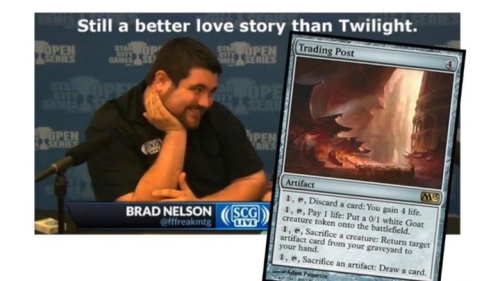
Check it out in play:
Only a month later, a Tezzeret deck with 4 Trading Posts ended up getting 2nd Place in a Magic Online Daily! This deck had some choices that I really liked (Phyrexian Metamorph being one, Staff of Nin for another), and some choices I don’t care for that were also in Brad’s deck (I just think Wellsprings were just too “do nothing” to be able to mess around with when Delver was in Standard).
Creatures (4)
Planeswalkers (3)
Lands (23)
Spells (30)

One of the things these two decks demonstrate is the power of both come-into-play effects with artifacts, but also making use of the death of artifacts and creatures. These abilities are used a little less intently by another build of Trading Post from the past, Andrew Cuneo’s UW Trading Post from about a year ago:
Lands (26)
Spells (34)
- 2 Dissipate
- 4 Think Twice
- 2 Prophetic Prism
- 1 Elixir of Immortality
- 4 Ratchet Bomb
- 3 Trading Post
- 4 Azorius Charm
- 4 Supreme Verdict
- 2 Detention Sphere
- 3 Sphinx's Revelation
- 1 Codex Shredder
- 1 Blind Obedience
- 1 Azorius Cluestone
- 2 Haunted Plate Mail
Sideboard

For my part, I was inspired by all of these decks, and I spent a great deal of effort back in August two years ago working on Trading Post decks. In my attempt to ‘fix’ Black Market I ended up with two decks that were quite solid, but neither of which really felt to me like they were over the top, especially given what the metagame looked like. I ended up with two Trading Post decks, a Monoblack Control Trading Post deck and a Big Red Trading Post deck.
For those interested in footnotes on footnotes in history, here are those decks:
Creatures (13)
Lands (24)
Spells (23)
- 4 Galvanic Blast
- 4 Sphere of the Suns
- 2 Slagstorm
- 4 Pristine Talisman
- 3 Batterskull
- 4 Bonfire of the Damned
- 2 Trading Post
Sideboard

The Phoenix deck was actually really powerful. Of course, it is important to note that these decks only ended up playing two Trading Posts each, and they didn’t go very deeply into being tricky with them. Perhaps the more important aftermath of these decks were the UW Control decks that Andrew Cuneo and I would build for Worlds that year.
I particularly like how both of these decks could just end up gaining a ton of life off of Batterskull and Pristine Talisman, buying time to make the rest of the deck take hold. The Phoenix deck’s ability to exploit the Trading Post was mostly with synergies rather than directly being a deck that went “Pop Bang Wow” when it had a Trading Post in play.
In many ways that informs this deck I’m going to share with you. This is only in the ‘brew’ stage, to be sure, but I thought I’d leave you with this Brainstorm of mine and see if it can inspire you. I can tell by looking at it the deck is missing something, and perhaps might not ever have what it takes to be a winner, but to me the point of these exercises is to push the envelop on the chance that something useful can be gleaned from it. When I think about how incredible Trading Post is in the sideboard of my build of U/W Control, it is only through being willing to try things that fail that you can find the surprising thing that works so well.
Enjoy.
Creatures (7)
Lands (24)
Spells (29)



